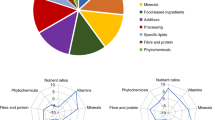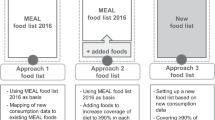Abstract
Background/Objectives:
The glycaemic index (GI) is used to describe the blood glucose-raising potential of carbohydrate-containing foods. Only a few descriptions of the addition of GI values to national food composition databases (FCDBs) exist. We tested whether the value documentation framework established within the European Food Information Resource (EuroFIR) Network could be used for GI values when adding them to the Finnish FCDB.
Methods:
The list of foods requiring GI values was based on the National FINDIET 2007 Survey data and extended with foods encoded in a food-frequency questionnaire used in other nationally representative studies. The minimum quality of GI measurements was verified when gathering values from various sources, using earlier defined criteria. If a measured GI value for a food was directly available, or could be imputed or estimated, the value was added to the Finnish FCDB and documented using core standard vocabularies of EuroFIR. The GI values of composite foods were calculated using recipe calculation software.
Results:
A total of 2210 foods required a GI value. GI values for 1322 foods were available and added to the FCDB. The remaining 888 foods were composite foods and received a GI value through recipe calculation. The standard vocabularies describing the origin of the GI values, the methods used in their derivation and their qualitative characteristics were suitable for GI values.
Conclusions:
GI values can be added to FCDBs and documented using terms similar to those used for traditional food composition data. Standardised value documentation may provide transparency for GI database compilation processes.
This is a preview of subscription content, access via your institution
Access options
Subscribe to this journal
Receive 12 print issues and online access
$259.00 per year
only $21.58 per issue
Buy this article
- Purchase on Springer Link
- Instant access to full article PDF
Prices may be subject to local taxes which are calculated during checkout
Similar content being viewed by others
References
Atkinson FS, Foster-Powell K, Brand-Miller JC (2008). International tables of glycemic index and glycemic load values: 2008. Diabetes Care 31, 2281–2283.
Aziz A (2009). The glycemic index: methodological aspects related to the interpretation of health effects and to regulatory labeling. J AOAC Int 92, 879–887.
Barclay AW, Petocz P, McMillan-Price J, Flood VM, Prvan T, Mitchell P et al. (2008). Glycemic index, glycemic load, and chronic disease risk—a meta-analysis of observational studies. Am J Clin Nutr 87, 627–637.
Brouns F, Björck I, Frayn KN, Gibbs AL, Lang V, Slama G et al. (2005). Glycaemic index methodology. Nutr Res Rev 18, 145–171.
CEN (European Committee for Standardization) (2009). CEN/TC 387. Project Committee—Food data. Available at: http://www.cen.eu (accessed April 2010).
Du H, Van der AD, Feskens EJ (2006). Dietary glycaemic index: a review of the physiological mechanisms and observed health impacts. Acta Cardiol 61, 383–397.
EuroFIR (2009). European Food Information Resource Network. Available at: http://www.eurofir.eu (accessed April 2010).
FAO/WHO (Food and Agriculture Organization of the United Nations/World Health Organization) (1998). Carbohydrates in human nutrition. Report of a Joint FAO/WHO Expert Consultation. FAO Food Nutr Pap 66, 1–140.
Flood A, Subar AF, Hull SG, Zimmerman TP, Jenkins DJ, Schatzkin A (2006). Methodology for adding glycemic load values to the National Cancer Institute Diet History Questionnaire database. J Am Diet Assoc 106, 393–402.
Heistaro S (2008). Methodology report. The Health 2000 Survey. Publications of the National Public Health Institute B 26/2008. Helsinki: National Public Health Institute, pp 1–246. Available at: http://www.terveys2000.fi/publications.html (accessed April 2010).
Howlett J, Ashwell M (2008). Glycemic response and health: summary of a workshop. Am J Clin Nutr 87, 212S–216S.
Hätönen KA, Similä ME, Virtamo JR, Eriksson JG, Hannila ML, Sinkko HK et al. (2006). Methodologic considerations in the measurement of glycemic index: glycemic response to rye bread, oatmeal porridge, and mashed potato. Am J Clin Nutr 84, 1055–1061.
Jenkins DJ, Wolever TM, Taylor RH, Barker H, Fielden H, Baldwin JM et al. (1981). Glycemic index of foods: a physiological basis for carbohydrate exchange. Am J Clin Nutr 34, 362–366.
Konttinen H, Männistö S, Sarlio-Lähteenkorva S, Silventoinen K, Haukkala A (2010). Emotional eating, depressive symptoms and self-reported food consumption. A population-based study. Appetite 54, 473–479.
Mann J, Cummings JH, Englyst HN, Key T, Liu S, Riccardi G et al. (2007). FAO/WHO scientific update on carbohydrates in human nutrition: conclusions. Eur J Clin Nutr 61, S132–S137.
Martin CL, Murphy SP, Au DLM (2008). Compiling glycemic index and glycemic load values for addition to a food composition database. J Food Compos Anal 21, 469–473.
Møller A, Unwin IA, Ireland J, Roe MA, Becker W, Colombani P (2008). The EuroFIR Thesauri 2008. EuroFIR Technical Report D1.8.22. Danish Food Information: Denmark, pp 1–64. Available at: http://www.eurofir.eu/eurofir_knowledge/eurofir_thesauri (accessed April 2010).
Monro JA (2002). Glycaemic glucose equivalent: combining carbohydrate content, quantity and glycaemic index of foods for precision in glycaemia management. Asia Pac J Clin Nutr 11, 217–225.
Neuhouser ML, Tinker LF, Thomson C, Caan B, Horn LV, Snetselaar L et al. (2006). Development of a glycemic index database for food frequency questionnaires used in epidemiologic studies. J Nutr 136, 1604–1609.
Olendzki BC, Ma Y, Culver AL, Ockene IS, Griffith JA, Hafner AR et al. (2006). Methodology for adding glycemic index and glycemic load values to 24-h dietary recall database. Nutrition 22, 1087–1095.
Paturi M, Tapanainen H, Reinivuo H, Pietinen P (eds) (2008). The National FINDIET 2007 Survey. Publications of the National Public Health Institute B 23/2008 (in Finnish, summary in English). National Public Health Institute: Helsinki, pp 1–228. Available at: http://www.ktl.fi/attachments/suomi/julkaisut/julkaisusarja_b/2008/2008b23.pdf (accessed April 2010).
Peltonen M, Harald K, Männistö S, Saarikoski L, Peltomäki P, Lund L et al. (2008). The National FINRISK 2007 Study. Publications of the National Public Health Institute B 34/2008 (in Finnish, summary in English). National Public Health Institute: Helsinki, pp 1–72. Available at: http://www.ktl.fi/attachments/finriski/2008b34.pdf (accessed April 2010).
Pennington JAT (2002). Food composition databases for bioactive food components. J Food Compos Anal 15, 419–434.
Pi-Sunyer FX (2002). Glycemic index and disease. Am J Clin Nutr 76, 290S–298S.
Reinivuo H, Bell S, Ovaskainen M-L (2009). Harmonisation of recipe calculation procedures in European food composition databases. J Food Compos Anal 22, 410–413.
Reinivuo H, Marjamäki L, Heikkilä M, Virtanen SM, Valsta L (2008). Revised Finnish dietary supplement database. J Food Compos Anal 21, 464–468.
Schakel S, Schauer R, Himes J, Harnack L, Van Heel N (2008). Development of a glycemic index database for dietary assessment. J Food Compos Anal 21, S50–S55.
Similä ME, Valsta LM, Virtanen MJ, Hätönen KA, Virtamo J (2009). Glycaemic index database for the epidemiological Alpha-Tocopherol, Beta-Carotene Cancer Prevention (ATBC) Study. Br J Nutr 101, 1400–1405.
THL (2009). Fineli, Finnish Food Composition Database. Release 10. THL (National institute for Health and Welfare), Nutrition Unit: Helsinki. Available at: http://www.fineli.fi (accessed April 2010).
van Bakel MM, Slimani N, Feskens EJ, Du H, Beulens JW, van der Schouw YT et al. (2009). Methodological challenges in the application of the glycemic index in epidemiological studies using data from the European Prospective Investigation into Cancer and Nutrition. J Nutr 139, 568–575.
Venn BJ, Green TJ (2007). Glycemic index and glycemic load: measurement issues and their effect on diet-disease relationships. Eur J Clin Nutr 61, S122–S131.
Wolever TM, Brand-Miller JC, Abernethy J, Astrup A, Atkinson F, Axelsen M et al. (2008). Measuring the glycemic index of foods: interlaboratory study. Am J Clin Nutr 87, 247S–257S.
Acknowledgements
This work was supported by the Academy of Finland (111420, 118065), the Finnish Cultural Foundation, the Juho Vainio Foundation and the Yrjö Jahnsson Foundation and completed on behalf of the EuroFIR consortium funded under the EU 6th Framework Food Quality and Safety Programme (FOOD-CT-2005-513944).
Author information
Authors and Affiliations
Corresponding author
Ethics declarations
Competing interests
The authors declare no conflict of interest.
Additional information
Contributors: NEK, LMV and SM contributed to the original conception of this work. NEK performed the assignment of GI values to foods in co-operation with MES, LMV and SM, and carried out the GI value documentation together with HP. TK performed the GI calculations. NEK wrote the paper and all co-authors critically appraised the paper.
Rights and permissions
About this article
Cite this article
Kaartinen, N., Similä, M., Pakkala, H. et al. Glycaemic index values in the Finnish food composition database: an approach to standardised value documentation. Eur J Clin Nutr 64 (Suppl 3), S68–S72 (2010). https://doi.org/10.1038/ejcn.2010.214
Published:
Issue Date:
DOI: https://doi.org/10.1038/ejcn.2010.214



